 In this article, we will trace the history of the development of the most popular free operating system in the world – Andorid. Today it is worth more than 5 billion devices worldwide. These are phones, tablets, household appliances, and wireless cars in industry.
In this article, we will trace the history of the development of the most popular free operating system in the world – Andorid. Today it is worth more than 5 billion devices worldwide. These are phones, tablets, household appliances, and wireless cars in industry.
By the way, the title of each version of Android uses the name of some sweet. Try to guess this name from the pictures in the article.
So where did it all start?
Android 1.5 Cupcake
In 2008, when pinch zoom (the image can be scaled with two fingers) was only available on iPhone, and in addition to modern Android and iOS, there were smartphones running BlackBerry OS – a new player has entered the game – Android.
The first available smartphone on Android was HTC Dream – a smartphone with a sliding QWERTY keyboard that ran on Android 1.5 (in the US it was called T-Mobile G1). When creating this operating system, Linux was taken as a basis. Android offered the user something completely new, something that users did not have iPhone: freedom and endless possibilities.

Android is an open source system.
Compared to closed from any outside interference iOS, Android gave users almost complete freedom of action. The Android Market (now known as the Google Play Store) was born, which was completely free. Users could also play with the system's appearance in every possible way by adding various widgets to the home screen, which provided quick access to the functions of some applications without launching them.
This is how the journey of one of the most popular mobile operating systems of our time began.
to the content
Android 1.6 Donut
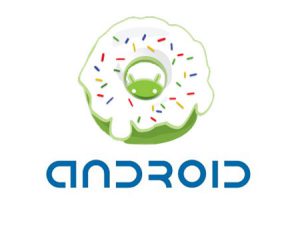
The beginning of the era of smartphones with large screens.
The next version (1.6 Donut) was announced in 2009. Many people associate this update with the appearance of the first smartphones with large screens, which today do not fit in a trouser pocket.
In fact, Donut was focused on large screens (tablets), but it laid the foundations for the first “phablets”, and since Android 1.6 worked on devices with larger screens than Cupcake, the appearance of phablets did not force wait a long time.
For example, the 5-inch Dell Streak, although not large by modern standards, has made a splash, thanks in large part to the new system that supports large screens.
The text-to-speech technology was introduced, the search function was improved. Now you could monitor the level of battery consumption: the system showed which applications are using the most battery.
to the content
Android 2.0 Eclair
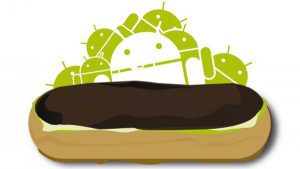
Added support for multi-touch technology (multitouch).
Who knew we might someday be able to use multiple Google accounts at once?
In the new update, various restrictions related to the use of accounts and much more have been removed.
By the way, the new version got its name in honor of the French confectionery.
But the ability to use multiple accounts was not a major novelty Android 2.0. The release of Eclair was marked by the emergence of multitouch support (previously this technology was used only on smartphones Apple).
Android and iOS became two competing platforms, and Android was rapidly gaining momentum.
Also introduced was GPS navigation on Google Maps, new shooting modes, live wallpapers and support for Bluetooth 2.1.
to the content
Android 2.2 Froyo

Froyo, aka frozen yogurt, is the fourth major update Android. More and more smartphones were released on this OS (Samsung Galaxy S2, HTC Incredible S, etc.) With the release of Android 2.2, Google began to step on Apple right on its heels. The system has become much more convenient, and finally it became reasonable to compare it with iOS.
Android – smartphones became a worthy alternative to the iPhone: they started using Super AMOLED screens, which were significantly superior in quality to LCD – screens in iPhone. In addition, many Android smartphones boasted attractive designs.
In Android 2.2 a new feature was added that made them a little more attractive to the average user than iPhone – the main novelty of Froyo is the ability to use a smartphone as a mobile Wi-Fi hotspot.
The idea of distributing high-speed 3G internet to laptops and other smartphones was a huge success.
Apple it took a full year to add this feature to their devices. Some operators still block the Internet distribution function.
to the content
Android 2.3 Gingerbread

Android Gingerbread hasn't been as successful as Froyo, but a lot of new features have been added: Internet calls, a download manager for long downloads, and support for new sensors like NFC.
The main novelty was support for copying and pasting, which suggested itself for a long time, since iPhones acquired this function a year earlier.
Before Gingerbread, copying text on Android smartphones worked very crookedly: you couldn't copy a single word, you had to copy the entire line. But in 2010, it became possible to copy individual words by long pressing on the desired word, after which a context menu with the ability to copy and paste was opened.
to the content
Android 3.0 Honeycomb
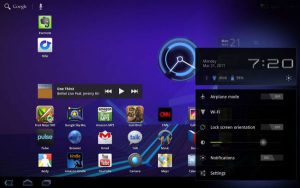
Remember Motorola Xoom? Not to be confused with Microsoft Zune – we're talking about the company's tablet Motorola, which ran a tablet-adapted version Android subtitled Honeycomb.
The main difference between this version and all the others was the interface. The interface used icons with a three-dimensional image. The style of the new version was reminiscent of the Tron movie: glowing lines, gradient lighting of various elements – everything looked very cool.
Modern smartphones are produced without physical navigation buttons: buttons “Back”, “Home”, “Current applications” are now software (touch).
Oddly enough, but soft buttons appeared for the first time in the tablet version of Honeycomb. They were located on the lower left side of the screen.
to the content
Android 4.0 Ice Cream Sandwich
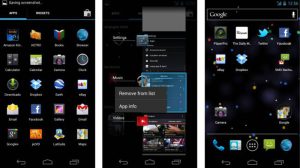
Ice Cream Sandwich (“ice cream”) has become the most update-rich version Android in its history.
Some of the first smartphones on the new Android were the Galaxy Nexus and HTC One X. Android 4.0 introduced a wonderful photo editor, and significantly expanded security and data control capabilities.
Google continued to develop the design idea from Honeycomb: a lot of work was done on the new interface.
The main novelty is the emergence of a new gesture “Remove with shift / swipe”. This gesture has been used by many companies for a long time, but its official appearance in the system ensured its widespread use.
This gesture made it possible to remove the notification of the received message. The novelty has given a strong impetus to the development of gesture technology in Windows 10 Mobile, and the popular dating app Tinder is also working on this gesture.
to the content
Android 4.1 Jelly Bean

Android 4.1 became bug fixes in Android 4.0. Performance has been improved, support for multiple languages has been added, and widgets are automatically resized based on screen size.
Android 4.2 was another bug fix for previous versions, but this time for tablets. In this version, the interface has been improved, and support for the technology of wireless multimedia signal transmission – Miracast, has appeared.
The latest version of Jelly Bean – Android 4.3 was dedicated to software tools for developers. A new version of AVRCP 1.3 was also added for Bluetooth, which made it possible to connect two devices with the help of Bluetooth, and also with the help of Bluetooth it was possible to impose various restrictions on other accounts if multiple accounts were used on the device.
The main novelty of Jelly Bean is extended notifications. To get more detailed information about the received notification, it was necessary to swipe down on the notification using two fingers. For example, if you receive a notification from Twitter about 3 new tweets from other users, swipe down with two fingers to see who posted those tweets with part of the message itself. This feature is present in Android to this day.
to the content
Android 4.4 Kitkat

The first emoji on the Google keyboard, optimization Android for budget devices with 512MB of RAM, improved NFC security made contactless payments with a smartphone real – all this and much more has been added in the new Android 4.4 KitKat.
The main innovation of the version was the active voice assistant – Google Now, which marked the beginning of the development of all smart voice assistants today.
Activated using the command: “Okay Google,” the voice assistant was introduced in October 2013, significantly expanding the capabilities of Google Search.
The next introduced their voice assistant “Siri” – Apple, in June 2014. And the race between the two operating systems has split into a race between smartphones and voice assistants. In the second case, Google is noticeably ahead of its competitor.
to the content
Android 5.0 Lollipop

Material Design – a new user interface based on simplicity, brightness, clarity and functionality, has become one of the main innovations Android 5.0.
Support for 64-bit architecture was introduced, which helped Android move on a par with desktop operating systems. Notifications have become somewhat more convenient: they are now displayed on the lock screen. To open them, you had to tap one of them twice.
But the gem of Android Lollipop is its support for Bluetooth LE or Bluetooth low power. This feature has significantly increased the operating time of the smartphone. The new technology has allowed manufacturers to create miniature devices such as smartwatches and fitness bracelets with low-capacity batteries.
to the content
Android 6.0 Marshmallow

Android 6.0 first appeared on Nexus 5X and Nexus 6P devices. These devices were manufactured with a new generation USB connector – USB Type-C, and a fingerprint scanner.
The security and control of applications was increased, especially those applications that required access to the camera and other things for their work.
Android 6.0 also supported the ability to use microSD cards to expand internal storage Android. This feature was especially useful for devices with less than 16 GB of internal storage, but this feature was soon removed.
Doze Mode: This is the second time that the battery saver feature is the highlight of the new update.
If you left your smartphone turned off for a certain period of time, Doze mode was activated, which limited the operation of background applications, which conserved battery power.
This allowed a noticeable increase in the battery life compared to iPhone, which made Android – smartphones more attractive to buy.
to the content
Android 7.0 Nougat

Multi-window mode
Fast switching between applications using a double tap on the “Running applications” button, even more emoji, different wallpapers for the main screen and lock screen … With the release of Nougat, Android just got better. This update has borrowed a lot from Samsung devices.
By introducing split-screen functionality in the Samsung Galaxy Note lineup, the company was the first to add multi-window mode to its smartphones. And now, a year later, Google announces this feature for Android OS, which was the main innovation in Nougat. The peculiarity of this technology was to split the screen into 2 parts, as a result, you could use 2 applications at the same time.
Google added some cool features, for example, you could open two tabs at once in Google Chrome. You could also drag and drop images between the two tabs.
to the content
Android 8.0 Oreo
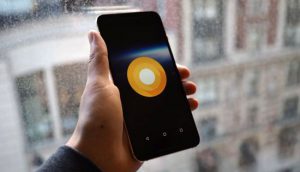
Updated battery menu and badges on app icons
In Android Oreo, the interface has been redesigned, the management of the built-in memory has been improved: a new file manager has been added, and new settings have also appeared in the corresponding section in the main “Settings”.
The main novelty of the new update is the “Picture in Picture” technology. Another feature borrowed from Samsung and redesigned for stock Android.
The new mode consisted of a small video playback window, which was located on top of all applications on the screen, which allowed you to watch videos, and, for example, sit on Vkontakte.
In its original form, this mode was very awkward to use and, frankly, rather useless. Now Google has begun to refine it. The company is optimizing apps like Netflix, WhatsApp and YouTube for this mode.
to the content
Android 9.0 Pie
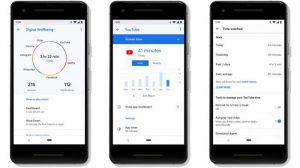
The latest version of the operating system at the moment Android, codenamed Pie (“pie”). So far, it is only available on flagship devices like Pixel 3 and 3 XL, Xalaxy S9 and S9 +.
The system was adapted for devices with “monobrow”, added a new adaptive battery mode, a new Material Design 2 interface and gesture control, as in the new iPhone X. With the release of this system, it became clear that Google is already in full swing preparing its product for frameless smartphones.
Digital Wellbeing is a program that collects information about your smartphone use. For example, Dashboard tells you how much time you spend on various applications. In this program, you can restrict access to various applications so as not to hang in them around the clock.
The new program has a large number of settings: from various application limiters to adjusting the brightness and color of the screen, for example, the wind down mode, which makes the smartphone screen black and white at the time you specify.
As you can see, in 9 Android, Google decided to focus on the health of users.
Over the entire existence of the system, more than 14 versions have been released Android. As one of the most popular mobile systems, Android OS has over 2 billion users worldwide.
to the content
Android 10.0 Q?
What's next? Android 10 due out in the second half of 2019.
But what will Android 10 Q be called? The fact is that in the English language there are no sweets, the name of which begins with the letter “Q”, so we can only guess.
Follow the updates on our website and you will be among the first to know about the name of the new Android 10 Q and other news of this operating system.
